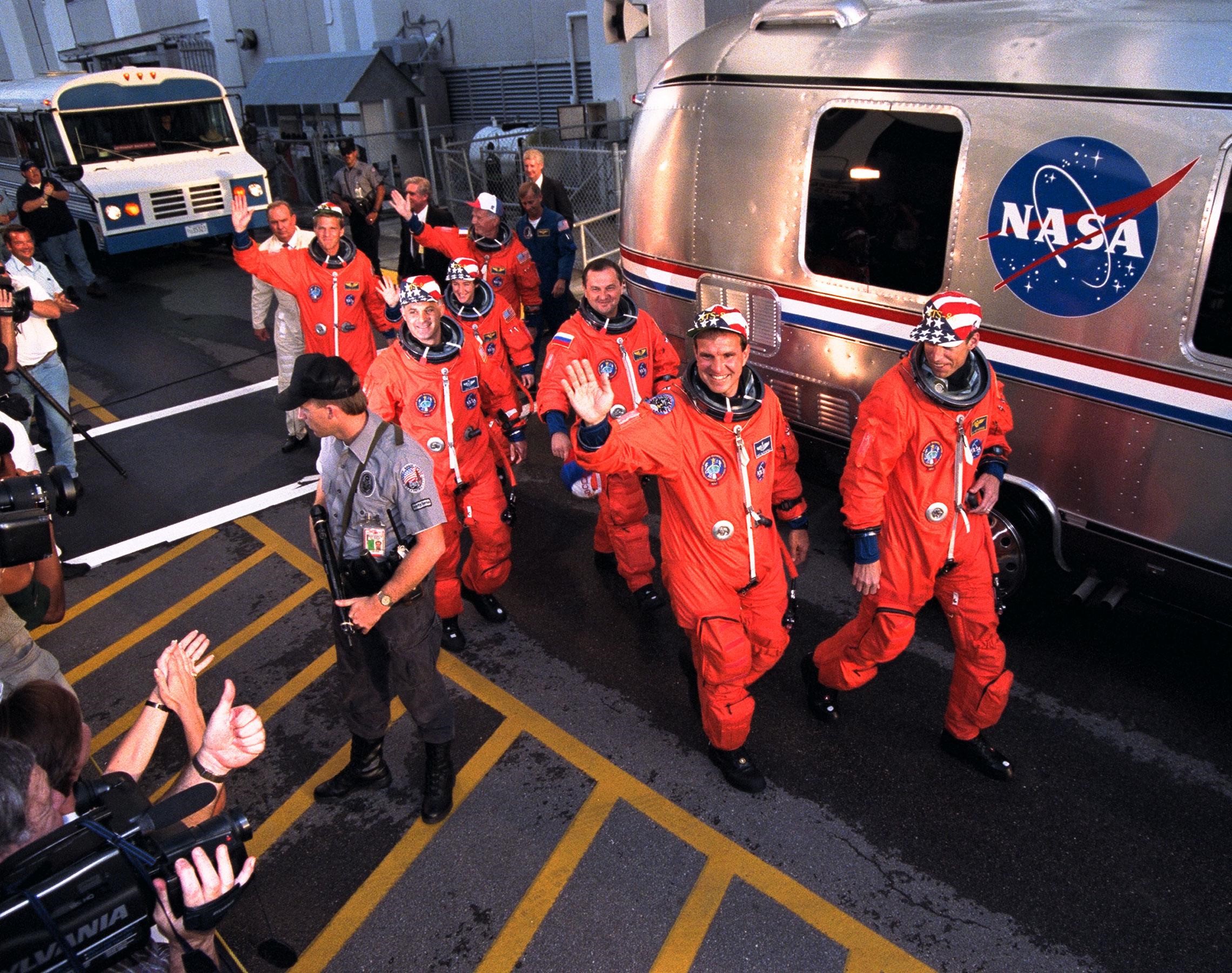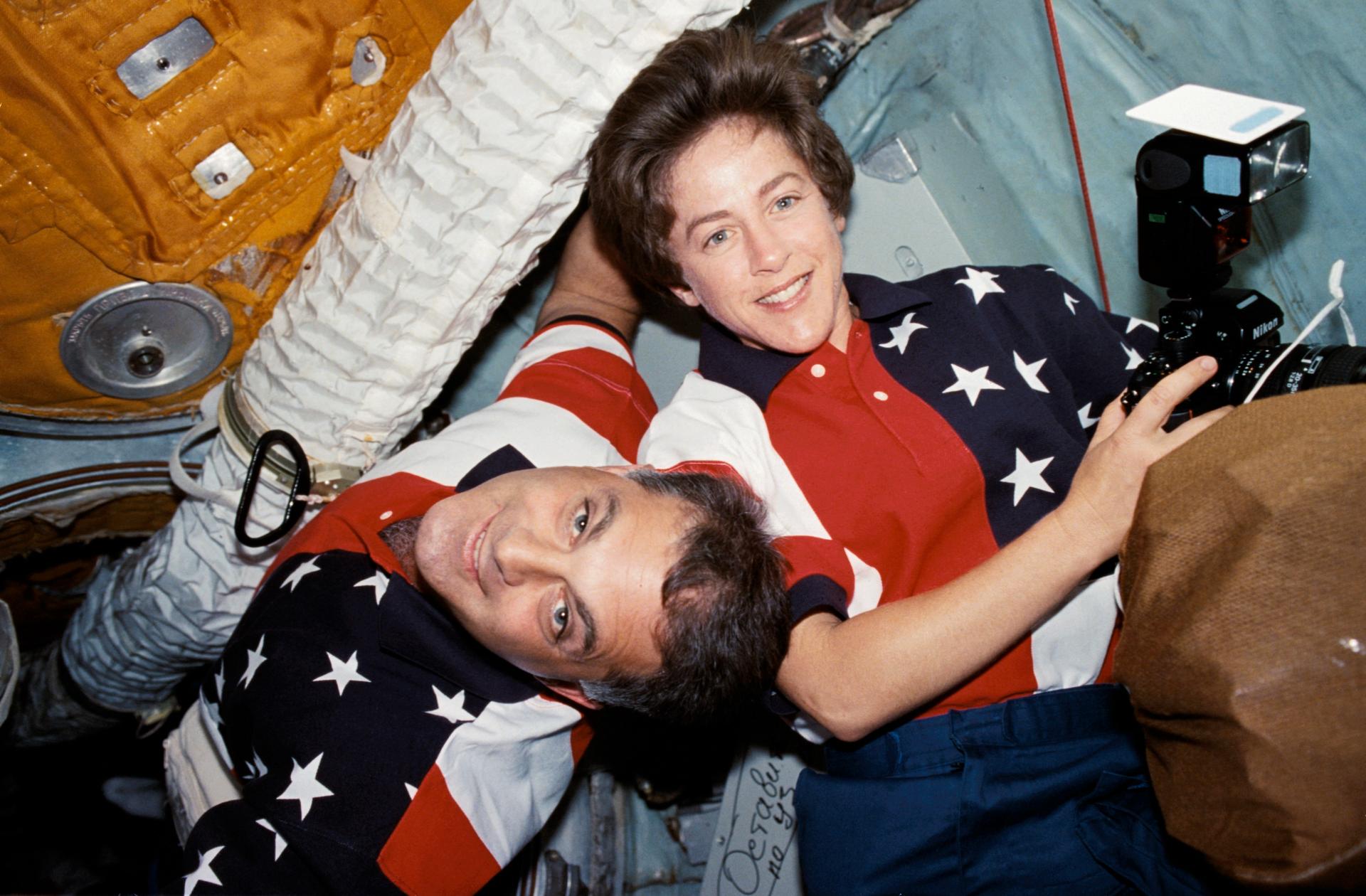Shuttle astronaut Wendy Lawrence talks spacesuits, Mir and learning Russian in 'Virtual Astronaut' webcast Friday
Lawrence's lecture will stream live Friday (Sept. 25) at 7 p.m. EDT (2300 GMT).

In October, if all goes to plan, the International Space Station (ISS) will celebrate 20 years of continuous human presence. That's two decades, 63 expeditions, and dozens of astronauts and cosmonauts who lived and worked on board the orbiting lab nonstop.
Former NASA astronaut Wendy Lawrence was supposed to fly in the predecessor program to ISS, called the Shuttle-Mir program. A handful of astronauts from NASA's space shuttle program spent a few months each on the Russian (formerly Soviet) Mir space station in the 1990s. This allowed them to train regularly for the first time with cosmonauts, or Russian spaceflyers, since the joint NASA-Soviet Apollo-Soyuz mission of 1975.
But Lawrence will soon deliver a virtual talk that, in part, addresses a time when she was pulled from her planned four-month Mir mission due to a suit sizing issue. Lawrence's lecture on "The Virtual Astronaut" live event series will stream live Friday (Sept. 25) at 7 p.m. EDT (2300 GMT), and you can purchase tickets here.
Related: The International Space Station at 20: a photo tour
Observers of today may start to draw analogies with the first all-woman spacewalk of 2019, which was delayed by several months due to one of the astronauts finding out in orbit that the medium-sized version of NASA's extravehicular mobility unit (EMU), or spacesuit, was not comfortable for spacewalking. Rather than prepping a small-sized suit for outside, NASA decided to postpone the historic all-woman spacewalk and ship another suit to space rather than spend several hours of astronaut time changing out parts in orbit.
Lawrence, though, is quick to say she thinks there is little correlation between the two incidents. "Different program," she told Space.com of the NASA all-female spacewalk sizing issue. "Different suit."
Lawrence was certified to serve on Mir and had plunged deep into Russian training, including spending nearly a year from 1996 to 1997 at the Gagarin Cosmonaut Training Center in Star City, Russia (near Moscow). But she was not certified for spacewalking, or extravehicular activities, because she was too small to fit in a Russian Orlan suit — the only spacesuit available on Mir for spacewalking, according to NASA.
Breaking space news, the latest updates on rocket launches, skywatching events and more!
Related: The evolution of the spacesuit in pictures
Initially this was not an issue for Lawrence because no spacewalks were scheduled for her stay. However, an uncrewed spacecraft accidentally slammed into Mir during docking in spring 1997. The Russians said NASA astronauts visiting Mir may need to help repair the damage, according to media reports of the time. Lawrence was replaced with NASA astronaut David Wolf, who spent nine hours spacewalking during the Expedition 24 mission on Mir.
Recalling the incident decades later to Space.com, Lawrence emphasized these were different circumstances than NASA's delayed spacewalk in 2019 — and that she understood "a decision had to be made" that resulted in her leaving the Shuttle-Mir program.
"It was clear I didn't fit the suit, and there was no way around it. It simply did not fit me. That pretty much put an end to that point of my Shuttle-Mir training, and off I went in a different direction," Lawrence said.
Lawrence was reassigned. Instead of going up with the STS-86 shuttle crew to stay for a few months aboard Mir, Lawrence was assigned to the shuttle mission only. She spent nearly 11 days in space with the shuttle crew, aboard Atlantis. While she didn’t go to Mir for a long-duration mission, she still visited during STS-86, albeit for a few days. Likely in recognition of her training in Russia. Lawrence visited Mir again briefly in 1998 for STS-91, the ninth and final Shuttle-Mir docking mission.
Lawrence actually flew four times in space. All Shuttle-Mir astronauts were veteran spaceflyers, and prior to embarking on that training, she had been on mission STS-67 on the space shuttle Endeavour in 1995. She retired from NASA after flying a fourth space mission in 2005; STS-114 was the first "return to flight" excursion after the fatal Columbia space shuttle accident in 2003 killed seven astronauts, forcing design and programmatic changes for NASA's space shuttle program.
Most media coverage of astronauts tends to focus on their time in space, but Lawrence's ground experience shows a breadth of time in Russia that never resulted in a long-term space mission. In addition to her training there, she served as director of operations for NASA at the Gagarin Cosmonaut Training Center.
Shuttle-Mir was implemented shortly after the Soviet Union fell, leaving Russia a new country with an old, expensive space program. NASA and American politicians saw value in bringing the Russians on board with the United States' space activities to use the Russians' many years of long-duration spaceflight experience.
There were many benefits to both space programs. Payments from NASA would allow Russia to keep employing its space technicians during a time of Russian economic instability. For NASA, collaborating with Russia also provided a new partner for the young International Space Station program, which replaced the over-budget and canceled Freedom space station program that was supposed to be a symbol against Communism.
During Shuttle-Mir, however, politics was not so much on the spaceflyers' minds, according to Lawrence. Lawrence said that the NASA astronauts quickly discovered the language of space was universal when interacting with the Russian cosmonauts, even though learning Russian was one of the more difficult things of her long-duration training. "Preparing for a mission was pretty challenging. Imagine doing it in the language that's not your native language," she said.
The U.S. Foreign Service Institute (FSI) classifies Russian among its "Category III languages," meaning that they are considered "hard" due to "significant linguistic and/or cultural differences from English." Achieving reasonable fluency in Russian takes about 44 weeks of full-time study for an English speaker, compared with languages such as Spanish or French that require roughly 24 to 30 weeks, under FSI standards.
Modern-day astronauts engage in several years of Russian training before embarking to space, starting with their approximately two years of basic astronaut candidate training that certifies them for spaceflight. Learning Russian for astronauts often includes activities such as living with Russian families and engaging in cultural Russian activities to gain more practice in the language.
For Lawrence, however, most NASA astronauts of her day had been hired when Russia was a Cold War enemy, so nobody was trained in the language upon joining NASA. Military astronauts like Lawrence, who came from the Navy, had been trained to think of the Soviet Union as an enemy. So the Shuttle-Mir astronauts therefore had to catch up quickly, in terms of language and cultural understanding.
Lawrence received an excellent Russian language trainer in Star City, and said despite the challenges, she looked forward to the regular meetings because she learned a lot about Russian culture as well. Other astronauts tried out approaches such as training at the Defense Language Institute, but said that time in Monterey, California took them far away from their families during a training cycle that already brought them frequently to Russia, Lawrence said.
Eventually, NASA opted to bring Russian language instructors to the Johnson Space Center in Houston, where American astronauts are based and where most have their homes. For eight hours a day, five days a week, the Shuttle-Mir astronauts would learn Russian, Lawrence said.
Related: Do we need a single international language in space?
While the Americans caught up in Russian, they worked with their new space station partners to bring modern-day computer simulations to space training. Lawrence said she was surprised that the Russian "rendezvous" training, which showed cosmonauts how to safely move their spacecraft close to Mir for docking, initially "still had a model basically on a string." But that training methodology was replaced.
Lawrence will deliver her talk in support of the non-profit Higher Orbits, which the astronaut has supported in the past. Among the activities of Higher Orbits, the organization allows student teams to come up with experiments to potentially fly to the ISS.
"It gives high school students a fabulous opportunity. If I had been presented with this opportunity [as a student], I would have jumped on it," Lawrence said, adding she never wants money to stand in the way of a student receiving "a life-changing opportunity."
Follow Elizabeth Howell on Twitter @howellspace. Follow us on Twitter @Spacedotcom and on Facebook.

Elizabeth Howell (she/her), Ph.D., was a staff writer in the spaceflight channel between 2022 and 2024 specializing in Canadian space news. She was contributing writer for Space.com for 10 years from 2012 to 2024. Elizabeth's reporting includes multiple exclusives with the White House, leading world coverage about a lost-and-found space tomato on the International Space Station, witnessing five human spaceflight launches on two continents, flying parabolic, working inside a spacesuit, and participating in a simulated Mars mission. Her latest book, "Why Am I Taller?" (ECW Press, 2022) is co-written with astronaut Dave Williams.




